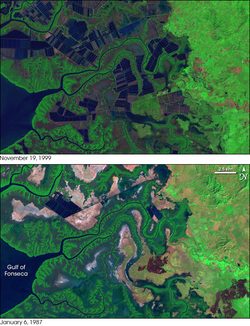Mariculture

Before & after of how mariculture decimates mangroves.
The Philippines and Ecuador have converted more than 50% of their mangroves into shrimp farms by mid 1990's. This practice decreases the amount of wild shrimp larvae in the area because they initially need the wild larvae to seed their ponds with. Shrimp farming in terms of catch per unit effort reached its peak in 1982, and is now at its lowest. Abandoned shrimp ponds cannot be reforested with mangroves due to the now exposed acid-sulfate soils [1].
About 250,000 farmed hectares are now abandoned waste lands. They've been left after pollution and disease took over the ponds. Shrimp farming and its profits are short-lived, but they damage is long-lived. The United States, Canada, Japan, and Europe are the top consumers of shrimp in the world. Importing these shrimp to wealthy countries is taking its toll on the mangroves in the tropics, where the shrimp are farmed [5].
About 250,000 farmed hectares are now abandoned waste lands. They've been left after pollution and disease took over the ponds. Shrimp farming and its profits are short-lived, but they damage is long-lived. The United States, Canada, Japan, and Europe are the top consumers of shrimp in the world. Importing these shrimp to wealthy countries is taking its toll on the mangroves in the tropics, where the shrimp are farmed [5].
Video:
Mangroves and Shrimp: Finding Balance
Mangroves and Shrimp: Finding Balance
You can help reduce the consumption of imported farmed shrimp by taking the Shrimp Pledge located on the bottom of the Conservation page!
